
John Deere 520 Drawn Flail Shredder
Agriculture
- Front rubber deflectors
- Heavy-duty gearbox
- Steel rotor bearings
- Square rotor designed for superior strength
Featured List
- Cutting Width: 20 ft (6.1 m)
- Number of Knives: 124 pairs
- PTO HP: 120 – 270 hp (90 – 201 kW)
Featured Content
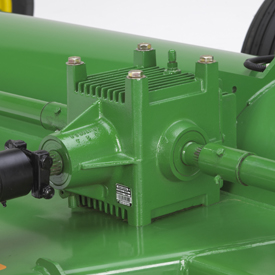
Gearbox
A heavy-duty, John Deere-designed and John Deere-built gearbox transfers power to the Kevlar® drive belts through cross shafts with intermediate bearing supports:
- The transmission is bolted directly to the frame.
- This gearbox has a constant-duty rating of 180 hp and a maximum rating of 270 hp.
- It carries a limited two-year warranty.
Kevlar is a U.S.-registered trademark of E.I. du Pont de Nemours and Company.
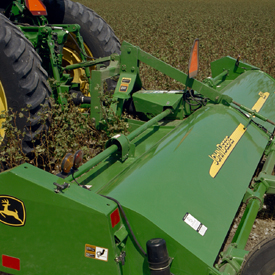
Hitch
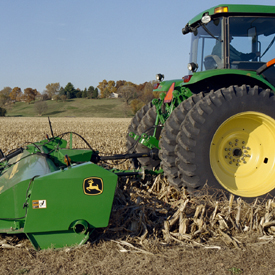
Drawn
The 520 Flail Shredder can be ordered with two different types of tractor hookup, drawn or integral, depending on preference. An integral flail shredder allows making a very tight turning radius, even when the tractor is equipped with dual wheels.
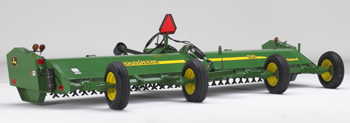
Wheel supports

Optional wheel supports eliminate the uncut middle strip in crops like wheat, oats, and barley. The shredder can be pulled at an angle, offsetting the rotors and cutting evenly across the entire width of the machine.
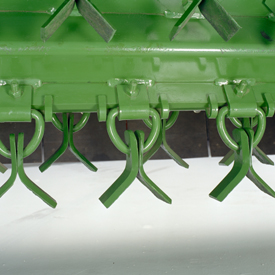
Flail fastening system

The flail fastening system eliminates clogging from mud or crop residue. Its bracket design also helps prevent knife and ring loss.
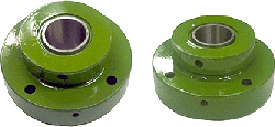
Rotor bearings
The rotor bearings are now made of steel and have a three-lip seal to keep the dirt out and increase the life of the bearings.
The side and center bearings now have guards in order to avoid leaks and dust, increasing the life of the bearings.
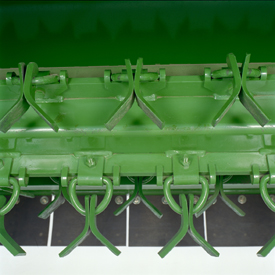
Rotor

Designed for superior rotor strength, the square rotor, together with the opposite-mounted flails, provides a machine with less potential vibration, increasing the life of rotor bearings and belts.
Since 248 knives are mounted on the full length of the rotors on the main cutterbar, with 2.5 cm (1 in.) of overlap, a stalk won’t get missed. This is a significant improvement over the 216 knives mounted on the previous 220 Flail Shredder.
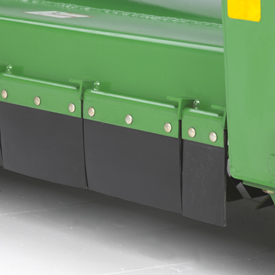
Rubber deflectors

Front rubber deflectors keep debris and other materials under the shredder and away from the tractor and operator. Because they are made out of rubber, they will not dent or rust.

Lateral-bearing service access

Center-bearing service access
Hard-to-reach center bearings can be serviced with the conveniently located grease fittings at the rear of the machine:
- There is no need for the operator to crawl under the machine to perform this service task, thus increasing the probability of the job being performed and completed safely.
| Power requirements - Tractor RPM | 1,000 rpm |
|---|---|
| Knives - Number of knives | 248 side slicer (124 pairs) |
| Knives - Knife mounting system | Bracket and D-ring |
| Knives - Type | Alloy steel, hardened with vanadium carbide and reversible |
| Rotor - Rotor speed | 2,000 rpm |
| Rotor - Rotor bearing | Double-row, barrel-type, triple-sealed, 2-year warranty |
| Drivetrain - Belts | Kevlar, 3/5V heavy-duty |
| Mainframe - Hitch | Drawn or Integral (Cat. 3 or 3N Quik-Coupler required) |
| Mainframe - Safety deflector | Rubber deflector |
| Mainframe - Gauge wheels | 4 (Drawn), 2 (Integral); infinitely adjustable |
| Mainframe - Warning lights | Integral (standard), drawn (optional) |
| Optional equipment - Easy transport | Available |
| Optional equipment - Constant velocity joint driveline | Available |
| Optional equipment - Skid shoes | Available |
| Knives - Tip speed | 224 km/h 139 mph |
| Cutting capacity - Cutting width | 6.1 m 20 ft |
| Dimensions - Weight | 2,268 kg 5,000 lb |
| Dimensions - Transport length | Endwise; drawn 7.34 m 24.08 ft Integral 2.39 m 7.83 ft |
| Cutting capacity - Cutting height | 7.6-25.4 cm 3-10 in. |
| Rotor - Rotor diameter | Square rotor 17.8 x 17.8 cm 7 x 7 in. |
| Rotor - Bearing size | 42.86 mm 1.69 in. |
| Dimensions - Transport width | Endwise; drawn 2.39 m 7.83 ft Integral 6.48 m 21.25 ft |
| Knives - Knives overlap | 27.18 mm 1.07 in. |
| Knives - Knife dimensions | 7.87 x 63.5 mm 0.31 x 2.5 in. |
| Power requirements - Tractor PTO hp range | Minimum 89 kg 120 hp |
| Drivetrain - PTO drivelines | 44.5 and 35.1 mm 1.75 and 1.38 in. |



